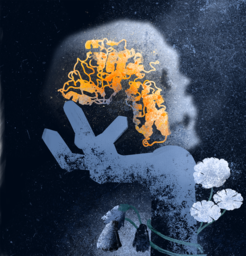Necroptosis Regulation: Balancing Life and Death
A new study reveals the dual role of MLKL in necroptosis, paving the way for new treatments for inflammatory diseases.
Scientists at the Max Planck Institute of Biophysics and the University of Cologne have discovered a complex mechanism by which cells regulate an inflammatory death process known as necroptosis. Their discovery led to the development of a new class of necroptosis inhibitors which shows an improvement in two mouse models with inflammatory conditions.
Text: Pamela Ornelas
In multicellular organisms, damaged cells are systematically removed to maintain health. When cells are identified as defective due to genetic issues, infections, or other factors, they can be either quietly recycled through apoptosis or destroyed via necroptosis. During necroptosis, cells release their contents and can trigger inflammation and activate the organism's immune system. While this response helps fight infections, necroptosis must be tightly regulated at the right time in the right place, otherwise it may worsen diseases like cancer, neurodegeneration, and autoimmune disorders. In some cases, necroptosis can also lead to tissue damage, raising the risk of heart attacks and strokes.
Necroptosis is activated when a protein called Mixed Lineage Kinase Domain-Like protein (MLKL) receives a signal from the cell that moves it to the cell’s membrane, where it disrupts its structure by creating a breach that causes the cell to burst open, executing necroptotic cell death.

A team of researchers led by Prof. Ana García-Sáez and Dr. Uris Ros has discovered that cells possess a built-in mechanism to regulate necroptosis using two forms of MLKL: a regular variant of MLKL that gets activated by external signals leading to cell death, and a modified version incapable of killing cells. This inactive version can help control the active MLKL, reducing its ability to mediate necroptosis. This way, cells can protect themselves from necroptosis by producing the inactive modified version of MLKL and slowing down the inflammatory process.
Proteins, like MLKL, are made of molecular building blocks called amino acids. Even small changes in their sequences can affect how proteins look and function. In this case, the inactive MLKL form contains a few extra amino acids. The results, published in the journal Molecular Cell, show that inserting these short additional building blocks modifies the 3D folding of the protein in a way that destroys its killing activity. This discovery led our researchers to identify a previously unknown mechanism of MLKL autoregulation uncovering a cavity in the protein that can be targeted with small drug-like molecules.
Using this knowledge, the authors developed a new strategy to inhibit MLKL and necroptosis. They identified small molecules that can bind this cavity and offer the potential to improve disease in mouse models of skin inflammation and abdominal aortic aneurysm. This research opens new possibilities for treating a broad range of inflammatory diseases linked to cell death in the future.












